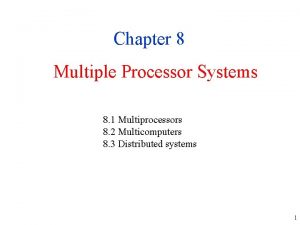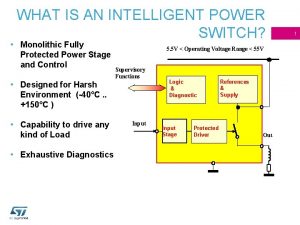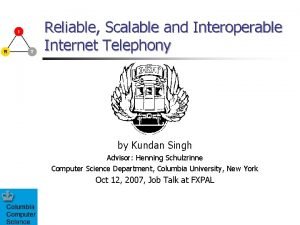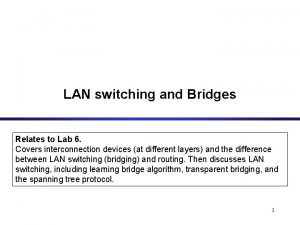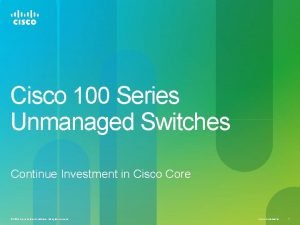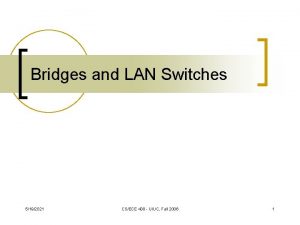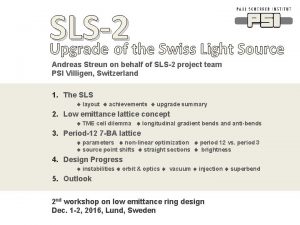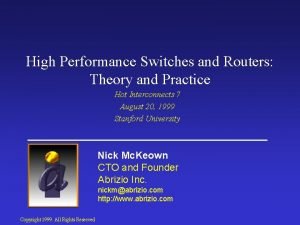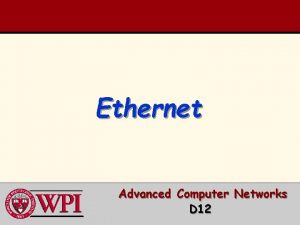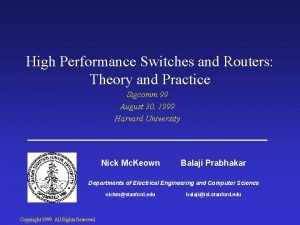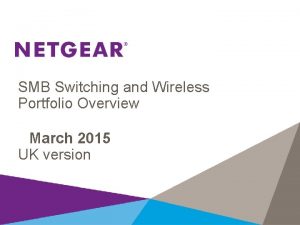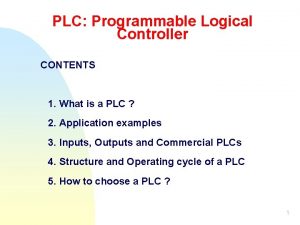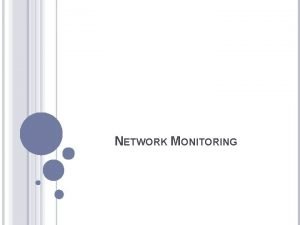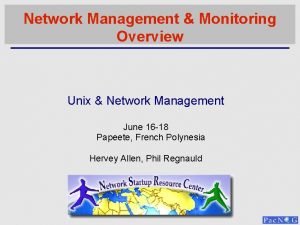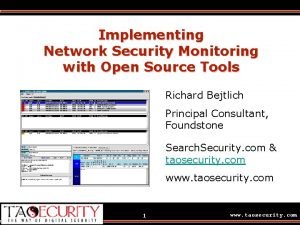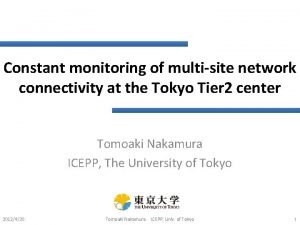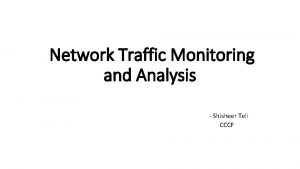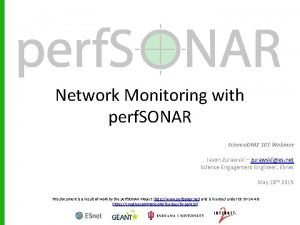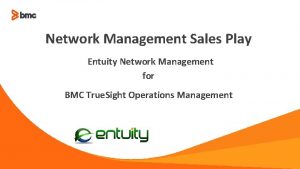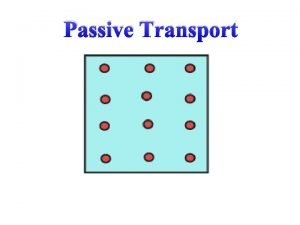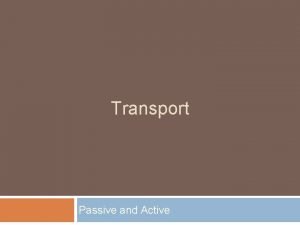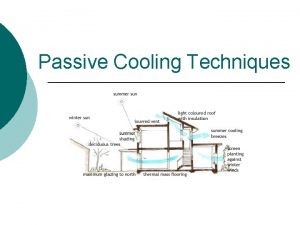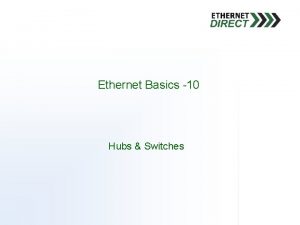LargeScale Passive Network Monitoring using Ordinary Switches Justin


































- Slides: 34

Large-Scale Passive Network Monitoring using Ordinary Switches Justin Scott Senior Network OPS engineer Juscott@microsoft. com Rich Groves Rgroves@a 10 networks. com

Preface • We are network Engineers • This isn’t a Microsoft Product • We are here to share methods and Knowledge. • Hopefully we can all continue to help foster evolution in the industry

About Justin Scott • Started career at MSFT in 2007. • Network Operations engineer, specialized in high profile, high stress outages • Turned to packet analysis to get through ambiguous problem statements • Frustrated by our inability to exonerate our network quickly. • Lack of ability to data mine telemetry data at the network layer Sharkfest 2014

What’s this about? • A different way of aggregate data from a TAP/SPAN • Our struggle with other approaches • An Architecture based on Open. Flow and use of commodity merchant silicon • A whole new world of use-cases • Learnings we’ve taken away

The Scale of the cloud • • • Thousands of 10 g links per Data Center 8, 16 and 32 x 10 g uplinks from TORs Cost makes it a non-starter with commercial solutions

Prior iterations • Capture-Net Ø Ø Consisted of off the shelf aggregation gear, which was far too expensive at scale high cost made tool purchases a difficult pitch, no point without tools Resulted in lots of gear gathering dust Operations not mature enough to back such a solution • PMA/PUMA –”Passive Measurement Architecture” Ø Lower cost than Capture-net Ø Designed for a specific environment and not intended to scale Ø Extremely feature rich • “Nemesys” AKA Rich’s crazy ideas Ø Big hub - Switched network with MAC learning turned off Left with shuffling sniffers around the DC as troubleshoots popped up.

Questions? NOT THE END Just took a step back

What features make up a packet broker? • • • terminates taps Can match on a 5 -tuple duplication 80% Packets unaltered low latency Stats Layer 7 packet inspection Time stamps 20% Frame Slicing Microburst detection Sharkfest 2014

Reversing the Packet Broker Filter Ports MUX backplane Filter Ports Service (pre-filter, de-duplication of data) Service Timestamps, DPI, etc Delivery Ports (data duplication and delivery) Delivery

Can You Spot the Off the Shelf Packet Broker? Which is 20 x more expensive? Is it called a Packet Broker cause it makes you broker? What do these have in common? They are all the same switch! -Raewyn Groves (Rich’s Daughter)

Architecture 11

The glue – SDN Controller • Openflow 1. 0 Ø Ø runs as an agent on the switch Standards managed by the Open Networking Foundation developed at Stanford 2007 -2010 Can match on SRC and/or DST fields of either TCP/UDP, IP, MAC. , ICMP code & types, Ethertype, Vlan id • Controller Discovers topology via LLDP • Can manage whole solution via remote API, CLI or web GUI

Multi-Tenant Distributed Ethernet Monitoring Appliance Enabling Packet Capture and Analysis at Enterprise Scale monitor ports mux filter service delivery Appliance tooling 20 X cheaper than “off the shelf” solutions

Filter Layer Monitor Ports Filter e • • Terminates all monitor ports Drops all traffic by default De-duplication of data if needed Aggressive s. Flow exports

Mux Layer Monitor Ports MUX • Aggregates all filter switches in a data center • Directs traffic to either service nodes or delivery interfaces • Enables service chaining per policy

Services Nodes monitor ports r Service • Aggregated by mux layer. • Majority of cost is here • Flows DON’T need to be sent through the service by default. • Service chaining Service Some Service: Deeper (layer 7) filtering Time stamping Microburst detection Traffic Ratio’s (SYN/SYNC ACK) Frame slicing - (64, 128 byte) Payload removal for compliance Rate limiting

Delivery Layer monitor ports r Delivery tooling • 1: N and N: 1 delivery to duplication of data • Delivery to local or tunneling to remote tools

Controller Router Filter_Switch 2 Filter_Switch 1 Filter_Switch 3 policy demo description ‘Ticket 12345689’ 1 match tcp dst-port 1. 1 2 match tcp src-port 1. 1 filter-interface Filter_Switch 1_Port 2 filter-interface Filter_Switch 2_Port 1 filter-interface Filter_Switch 2_Port 2 filter-interface Filter_Switch 3_Port 1 filter-interface Filter_Switch 3_Port 2 delivery-interface Capture_server_NIC 1

Extras controller • Intelligence of the solution Ø Ø Ø Ø Ø Overlapping flow support Vlan rewrite ARP glean Marker packet Stats Multi-User support Tap Port grouping Self terminating policy … bring your own innovation

Use Cases and Examples Microsoft Confidential – Internal Use Only 20

Reactive Ops Use-cases • Split the network into investigation domains. • Quickly exonerate or implicate the network • Time gained not physical moving sniffers from room to room • Verify TCP intelligent network appliance are operating as expected

IPV 6 Problem Statement: Users on a large ISP in Seattle are intermittently unable to connect to exchange via IPV 6. Repro facts: 3 -way TCP connection setup’s up. 9 -way SSL handshake fails Ack for Client hello doesn’t make it back to Loadbalancer Solution: Implicates or exonerates advanced L 7 devices that are commonly finger pointed Root cause: Race condition - If the client hello was received on the Load. Balancer, before the backend connection was made it would trigger the bug

Proactive monitoring Use-case • Relying sole on SNMP polling and syslogs gives you false confidence • Exposure to the underlying TCP telemetry data is true network performance data • Detect retransmissions (TCP-SACK)

Controller Router Filter_Switch 2 Filter_Switch 1 policy demo description “Ticket 12345689 – short desc” 1 match tcp dst-port 443 2 match tcp src-port 443 filter-interface Filter_Switch 1_Port 1 filter-interface Filter_Switch 1_Port 2 filter-interface Filter_Switch 2_Port 1 filter-interface Filter_Switch 2_Port 2 delivery-interface Capture_server_NIC 1 use-service remove_payload chain 1 use-service Layer_7_service_TCP_sack_match chain 2

Port-channels and delivery • Load-balance to multiple tools - Symmetric hashing • Duplicate data to multiple delivery interfaces • Binding portchannels to Openflow • Services expanding multiple interfaces

Increase Visibility on Large L 2 networks Connecting a filter-interface to a L 2 network as a trunked link Unicast flooding: NLB is a loadbalancing technology that doesn’t use traditional hardware based LB’s. Stolen gateway: Human fat fingers an IP address as the defaultgateway. Broadcasts: All fun in games until the rate of broadcasts increase over some duration and starve out legitimate traffic… AKA broadcast storm. STP TCN: A single packet that indicates the whole L 2 network CAM table is going to be flushed and relearnt. A single occurrence isn’t the end of the world, but if it’s frequent occurrence bad things are happening.

Adding s. Flow Analysis monitor ports filter 1 s. Flow samples sourced from all interfaces s. Fl ow Behavioral analysis mux delivery More meaningful captures are taken Controlle r s. Flow collector logic 27

Remote delivery monitor ports filter 1 Controlle r mux Production network delivery 28 Encap and send to remote tool in other DC Decap on arrival

Basic Openflow Pinger Functionality Spine packet is transmitted through the openflow control channel Spine Packet flows through the production network Leaf 1 Leaf 2 Packet is destined toward example dest 10. 1. 1. 1 Controller Demon 1588 Switch Openflow encap is removed inner packet is transmitted through specified output port Packets aredestined counted for Packets and timestamps controllerare readencapsulated for timing analysis through Openflow control channel Packet is crafted based on a template

Cost & Caveats 30

Solution breakdown Cost to build out a TAP infrastructure to support 200 10 gig links. Tap strip Filter Switch Capture Server Tap strip. Delivery Switch Filter Switch MUX Capture Server SDN Controller MUX Packet Broker Delivery Switch Packet Broker Number of links

Learnings of raw openflow solution Short term hurtles Ø TCAM limits Ø IPv 6 support Ø Lacking multivendor support in the same ecosystem Ø Can’t match on TCP/IP if packets encapsulated (MPLS, IP-IP) Ø Most services are static and have a 10 Gig cap. Openflow Ecosystem Ø switch vendors implement Openflow a little differently Ø Commercial controller support is splintering. Whitebox switches/bare metal Ø Total access/control of the underlying hardware

Questions ? 33

Microsoft is a great place to work! • We need experts like you. • We have larger than life problems to solve… and are well supported • Networking is critical to Microsoft's online success and well funded. • Washington is beautiful! • It doesn’t rain… that much. We just say that to keep people from cali from moving in
 Multiple processor systems
Multiple processor systems Ece 526
Ece 526 Vni4140
Vni4140 Types of switching
Types of switching Kundan switches models
Kundan switches models Which type of reaction
Which type of reaction Bridges vs switches
Bridges vs switches Small business rv router
Small business rv router Cisco 100 series switches
Cisco 100 series switches Bridges vs switches
Bridges vs switches Electropneumatics symbols
Electropneumatics symbols Mercury switches in cars
Mercury switches in cars Magnetic quadrupole
Magnetic quadrupole Two technicians are discussing schematic symbols
Two technicians are discussing schematic symbols High performance switches
High performance switches Switched pdu
Switched pdu Unica solutions
Unica solutions Series resonant inverter with bidirectional switches
Series resonant inverter with bidirectional switches High performance switches and routers
High performance switches and routers In a banyan switch micro switch
In a banyan switch micro switch A switch combines crossbar switches in several stages
A switch combines crossbar switches in several stages Zte ats
Zte ats Netgear gsm/fsm fully managed switches
Netgear gsm/fsm fully managed switches Used netgear gsm/fsm fully managed switches
Used netgear gsm/fsm fully managed switches Plc
Plc We should not touch electric switches with wet hands. why
We should not touch electric switches with wet hands. why High performance switches and routers
High performance switches and routers Sonar network monitoring
Sonar network monitoring Advantages of rmon
Advantages of rmon Big sister network monitor
Big sister network monitor Nsm network security monitoring open systems
Nsm network security monitoring open systems Multisite network connectivity
Multisite network connectivity Network traffic monitoring techniques
Network traffic monitoring techniques Sonar network monitoring
Sonar network monitoring Bmc entuity network monitoring
Bmc entuity network monitoring
